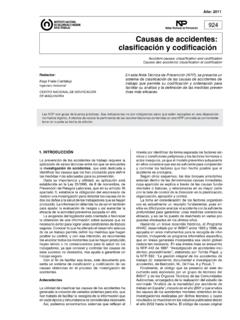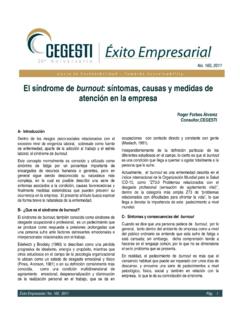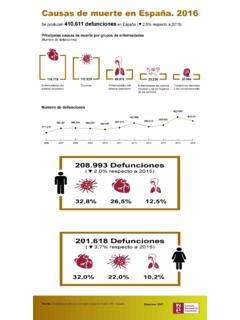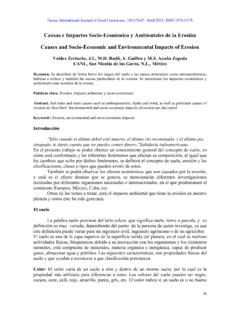Transcription of A method for deriving leading causes of death
1 297 Bulletin of the world health organization | April 2006, 84 (4)Objective A standard list for ranking leading causes of death worldwide does not exist. WHO headquarters, regional offices and Member States all use different lists that have varying levels of detail. We sought to derive a standard list to enable countries to identify their leading causes of death and to permit comparison between countries. Our aim is to share the criteria and methodology we used to bring some order to the construction of such a list, to provide a consistent procedure that can be used by others, and to give researchers and data owners an opportunity to utilize the list at national and subnational Results were primarily data-driven. Data from individual countries representing different regions of the world were extracted from the WHO Mortality Database. Supplementary information from WHO estimates on mortality was used for regions where data were scarce.
2 In addition, a set of criteria was used to group the candidate causes and to determine other causes that should be included on the A ranking list of the leading causes of death that contains broad cause groupings (such as all cancers , all heart diseases or all accidents ) is not effective and does not identify the leading individual causes within these broad groupings; thus it does not allow policy-makers to generate appropriate health advocacy and cost-effective interventions. Similarly, defining candidate causal groups too narrowly or including diseases that have a low frequency does not meet these For international comparisons, we recommend that countries use this list; it is based on extensive evidence and the application of public health disease-prevention criteria. It is not driven by political or financial motives. This list may be adapted for national statistical Cause of death /standards; Mortality/trends (source: MeSH, NLM).
3 Mots cl s Cause d c s/normes; Mortalit /orientations (source: MeSH, INSERM).Palabras clave Causa de muerte/normas; Mortalidad/tendencias (fuente: DeCS, BIREME).Bulletin of the world health organization 2006;84 page 301 le r sum en fran ais. En la p gina 302 figura un resumen en espa essential component of obtaining an overview of the mortality patterns in a population is to rank the causes of death in order of their frequency and public health importance. Ranking causes of death is a popular method of describing the relative importance of cause-specific mortality in a population because it is based solely on the number of deaths. A population denominator is not required. Individuals and organiza-tions frequently ask WHO for a list of the leading causes of death in countries, regions and the world by year, sex and age group. In response, WHO provides the information needed but it is always accompanied by a cautionary note about interpreting the results, which depend on the way in which the causes have been a Pan American health organization , Washington, DC, USA.
4 B world health organization , 1211 Geneva 27, Switzerland. Correspondence to Mrs Ma Fat (email: WHO Collaborating Centre for the Family of International Classifications in Portuguese, University of S o Paulo, S o Paulo, No. 05-028670(Submitted: 29 November 2005 Final revised version received: 29 November 2005 Accepted: 4 December 2005)A method for deriving leading causes of deathRoberto Becker,a John Silvi,a Doris Ma Fat,b Andr L Hours,b & Ruy Laurenticaggregated within the list. Why is it so difficult to provide the answer to such a straightforward question? The first reason is that there is no standard list or procedure used internationally to rank and compare the most frequent causes across countries. The second reason is that the way in which causes are grouped or split into subgroups will influence the rankings. The rank-order of any causal category depends on the list used; the application of different lists of causes and ranking rules will likely yield differ-ent leading causes of death .)
5 Moreover, a broad cause group, such as all circula-tory diseases , is more likely to score high in the rankings when compared with an individual disease, such as stroke. An additional objective of our work is to share the criteria and methodology used in deriving our list so that the method can be replicated by national statistical offices or health authorities to allow them to develop lists specific to certain age groups or populations. The sections below describe the criteria and methods that we used to derive a standard list to rank causes of International statistical classifica-tion of diseases and related health problems, tenth revision (ICD-10)1 implemented worldwide since 1994, contains 12 421 codes distributed among 2036 categories. The greater degree of detail over previous ICD revisions allows for more in-depth analyses by disease or specific causal group.
6 However, the use of such a level of detail to obtain a panoramic view of the health situation and identify the most relevant problems hinders the establish-ment of priorities and health policies. For this reason, the ICD itself offers shorter Arabic298 Bulletin of the world health organization | April 2006, 84 (4)ResearchA standard list for leading causes of death Roberto Becker et al. lists, based on the aggregation of several categories into a single group. It also offers four special (short or condensed) lists for tabulating mortality data and one for process utilized to create condensed tabulations lists should be based on the intended analysis. Criteria for defining cause-groups for biomedi-cal research usually require narrowly defined disease categories; the groups of criteria used to aid in organizing health -care delivery would be differ-ent than the groups used to assess the prevention and control efforts for major health problems.
7 Policy formula-tion would benefit from a short list of cause-groups that provides an overview of the health situation in a country or an area and assists decision-makers and researchers in visualizing prevailing and emerging mortality trends. Special at-tention should be paid to preventable mortality in the light of current knowl-edge and available technology and to the early detection of newly emerging causes of mortality. In order to be use-ful at the international level condensed lists must also facilitate intercountry tabulation lists for mortalityIn general, the following criteria should be followed when shortlists for the tabula-tion of mortality are The organization of the list should be based on the current revision of the ICD, and the categories of causes should be mutually exclusive. The rationale is that the list should be oriented towards current situations and used for many years.
8 The prepara-tion of an equivalent list for previous revisions of the ICD is a secondary objective. The categories should be as informa-tive as possible, avoiding residual categories usually identified by the expressions other , the remainder or not specified . However, in order to guarantee the inclusion of all events, at least one residual category (for example, all the remainder ) is necessary. In tabulating mortality data, the ill-defined causes (symptoms, signs and abnormal clinical and laboratory findings, chapter XVIII of ICD-10) should be shown separately and should not be a category on the list. This group is often used as a proxy indicator for data quality. The categories of the list do not need to follow the organization of the chapters of the ICD. Were they to do so, several residual categories would be required to complete the chapters, thereby increasing the proportion of events in categories which provide little useful information.
9 The categories of the list could cor-respond to single codes in ICD (the three-character categories but not the four-character subcategories) and codes in different chapters or entire chapters of the ICD, in accordance with the needs of those who use the data. The number of categories in a short list should be sufficiently broad to meet the requirements above but should not be excessive to the point of hindering its complete presentation. The majority of the shortlists used to tabulate mortality and morbidity have between 30 and 150 important axis along which causes of death can be grouped is pre-ventability criteria, as developed by Using Taucher s criteria, causal categories are oriented towards the defi-nition of priorities and the evaluation of health measures and programmes. This type of list, which can also be used for morbidity, has a structure in which there are large groups that include diseases that can be prevented by similar measures.
10 These would include, for example: deaths that can be avoidable by vac-cination ( measles or tetanus); deaths avoidable by early diagnosis and timely and adequate treatment ( tuberculosis, syphilis or causes of maternal mortality); deaths avoidable by application of hygienic measures, environmental sanitation, and health education ( intestinal infectious diseases, intoxi-cation due to air pollution); deaths avoidable by application of a combination of measures ( mea-sures that are included in more than one group); deaths that are difficult to avoid with current knowledge and technological development; and all the remaining deaths ( causes not identified by any of the previous groups).The preventability criteria of causes of death may vary depending on the mo-ment, the availability of technologies or resources, the experience of a country or region, and also when comparisons are made with specific paradigms.















